Oral language, Letter knowledge
Children will understand basic information, including the meaning of several novel words, presented in a book read aloud. Children will also identify the names of the letters B and C.


New:
Be Prepared: This is the first of three repeated readings of a book with children. Today’s reading focuses on children’s understanding of basic information presented in the book. In advance of the session, identify all novel words in the book you intend to define for children across three days of reading the book. Select one or two important words to define for children today, especially words that are essential to understanding the book. See the Language/Literacy section of the ELM User Guide: 3–5 Years for additional information. Write the following at the top of the chart paper: Words We Understand.
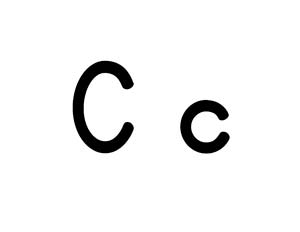
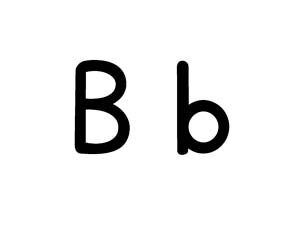 [Display the letter B card and the letter C card.]
[Display the letter B card and the letter C card.]
Now let’s read a book!
[See Week 3, Day 1 of Language/Literacy for a description and examples of how to approach today’s book reading. Key aspects are summarized below:
Number knowledge
Children will understand that when counting, the last number counted tells how many (cardinality).


New:

Today we will begin by learning a new song. The song is called “Ten Butterflies.” I will sing it first, and then we can sing it together.
[Sing the adjacent words to the tune of “Mary Had a Little Lamb.” Hold up one finger for each butterfly. Then encourage children to sing with you, using their fingers as butterflies.]
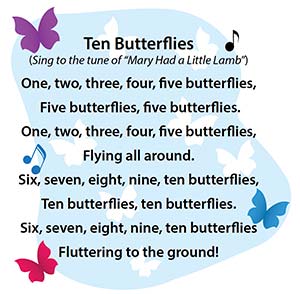 [Display card with stars.]
[Display card with stars.]
Let’s find out how many stars are on this card. I am going to count the stars on this card. Please watch and listen as I count. The last number I count will tell us how many stars are on this card.
[Point to each star as you count.]
There are ___ stars on the card. The last number counted tells us how many we have.
Now we are going to count together in groups. I will choose a card and then invite four children to count the stars together. I will point to the stars as you count.
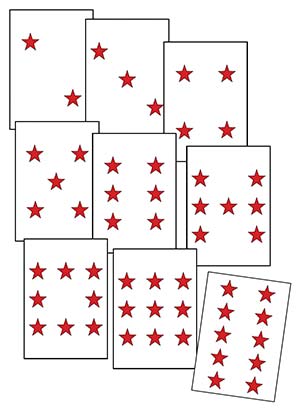 [Continue this activity by naming groups of four children to count together the stars on a different card. Point to the stars as children count from their seated position. Example: “Let’s have Amy, Darius, Damaris, and Caleb count the next group of stars.”
[Continue this activity by naming groups of four children to count together the stars on a different card. Point to the stars as children count from their seated position. Example: “Let’s have Amy, Darius, Damaris, and Caleb count the next group of stars.” Today we counted stars on cards to see how many stars there were. When we count, how do we know how many we have? (the last number we count tells us how many we have)
Extra support
Enrichment
Provide a basket of beanbags. Invite children to see how many times they can lightly toss and catch a beanbag in a row. Demonstrate how to lightly toss and catch a beanbag. Emphasize the counting element of this activity. Children may wish to toss/catch in pairs, making sure they take turns in tossing.
Play an outdoor game with all children in your setting. Invite children to practice counting as they toss balls into a bucket. To the first child, say a number between 1–10. Encourage the child to toss the same number of balls into a nearby bucket. As the child tosses the balls, encourage him/her to count the balls out loud. Example: Adult—“Emilio, please toss five balls into the bucket.” Child—“1, 2, 3, 4, 5.” Adult—“How many balls are in the bucket? How do you know?” Continue until each child has had a turn. Encourage children to count the number of balls they toss, not the number of balls that land in the bucket. Older children may enjoy counting to higher numbers or counting by twos as they toss two balls at a time into the bucket.
Concentrate
Children will understand how to use yoga poses to help concentrate on their breathing and bodies.


New:
Review:

Be Prepared: Today’s activity will involve children trying two yoga poses. If possible, provide children with yoga mats.
Today we will do another activity to help calm our minds and relax our bodies. Remember, when our bodies are relaxed our muscles are not tight. Our thoughts are quiet when our mind is calm. A relaxed body and calm mind can help us use good self-control.
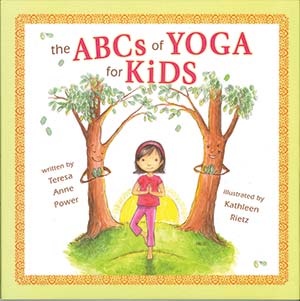 Today we will learn about yoga. Yoga is a way for us to concentrate on our breathing while stretching our bodies into different poses. Remember, a pose is a way of holding our body. There are many different poses in yoga. Yoga helps calm our mind and relax our body. We will learn about yoga today by reading two pages of a book called The ABC’s of Yoga for Kids. The book was written by Teresa Power.
Today we will learn about yoga. Yoga is a way for us to concentrate on our breathing while stretching our bodies into different poses. Remember, a pose is a way of holding our body. There are many different poses in yoga. Yoga helps calm our mind and relax our body. We will learn about yoga today by reading two pages of a book called The ABC’s of Yoga for Kids. The book was written by Teresa Power.
[Choose two poses from the book to demonstrate to children. Read sections of the book that focus on the two poses. Discuss how the child’s body is posed in each picture. Example: “This is called the airplane pose. How does her body look like an airplane?”]
When we do yoga, we will concentrate on our breathing while stretching our bodies in poses. We will take three deep breaths with each yoga pose. Let’s learn two poses today. Each of our poses may look different because our bodies are different and that’s okay.
[Show children the picture of the first chosen pose from the book. Demonstrate the pose and then invite children to try it. Remind children to take three deep breaths as they hold the pose. Repeat the pose with three deep breaths. Then show children the picture from the book of the second chosen pose and use the same approach for children. Repeat the pose with three deep breaths.]
Today we learned about yoga. Yoga helps us concentrate on our breathing while stretching our bodies. Did the yoga poses we tried help your body to feel relaxed? Did the poses help your mind to be calm?
Extra support
Enrichment
Place one or two yoga mats in an area of the room plus pictures (from book) of the two yoga poses practiced in today’s activity. If you do not have access to yoga mats, use a blanket. Play quiet, peaceful music and invite children to practice the poses.
Invite children in your setting to do partner yoga. Encourage one child to do a yoga pose and the other child to mimic the pose of the first child. Encourage children to take turns being the first to do a yoga pose. Provide The ABC’s of Yoga for Kids by Teresa Power for children to use as a reference.
Skills that support creative expression
Children will understand basic movements in dance.

None

Review:

We know that dance is one of the ways we can be creative. We move our bodies when we dance. Today we will learn about movements we can use when we dance. Remember, moving our body from one place to another is called a movement.
Moving forward is a movement that is used in dance. Remember, the word forward means to move toward what is in front of us.
[Demonstrate a forward movement by taking 2–3 steps forward.]
Let’s all stand and show how we can do a forward movement.
[Help children move apart so each has some personal space. Children should continue to face in the same direction. Encourage children to take several steps forward. Then invite them to remain standing.]
Moving backward is another movement that is used in dance. Remember, the word backward means to move toward what is behind us.
[Demonstrate a backward movement by taking 2–3 steps backward.]
Let’s show how we can do a backward movement.
[Encourage children to take several steps backward. Invite children to remain standing.]
Now let’s practice moving forward and then moving backward. First we need to spread out a little so we do not bump into each other.
Next, we need to listen carefully for different words I will say. The words are: forward movement, backward movement, and stop.
We need to walk slowly when I say “forward movement” or “backward movement.” We do not want to walk fast. We do not want to run. We walk slowly.
[Demonstrate slowly walking forward (3–4 steps). Say “stop” and stop walking. Then demonstrate slowly walking backward (2–3 steps). Say “stop” and stop walking.]
Let’s do our movements! Listen carefully to what I say.
[Offer requests in the following order. After children become familiar with the movements and process, you may wish to change the order and/or vary the amount of time for a movement. Remind children to walk slowly and to use their listening ears.]
Today we practiced a forward movement and a backward movement. We also practiced how to stop a movement. Movements are part of dancing.
Extra support
Enrichment
Invite children to put the forward and backward movements together in a short dance routine (omit the “stop”) that might also include some arm movements. Some children may wish to practice forward and/or backward movements with a friend, taking turns in providing the requests.
School-age children in your setting may enjoy creating and then teaching younger children a short dance routine that involves forward movement, backward movement, and arm movement.